Ministry of Sports in collaboration with the World Rally Championship (WRC), Safari Rally organizers have established a campaign to plant 19 million trees to promote environmental conservation and increase forest cover in the Country.
The tree seedlings planting drive took place at the Kenya Agricultural and Livestock Research Organization (KALRO) in Kisumu County. Other selected counties are also expected to participate in the greening exercise.
Under the Greening Legacy Project theme, WRC intends to achieve the target of 19 million trees by 2023 to commemorate the 19 years that Kenya was missing in the World Safari Rally sports.
The Cabinet Secretary for Sports Amb. Amina Mohamed and her counterpart from Environment and Wildlife, Keriako Tobiko, jointly rolled out the exercise on Wednesday where 653,000 tree seedlings were planted at Kakamega Forest.

“Our target is to create a Safari Forest at the Moi International Sports Centre, Kasarani and plant trees along the traditional safari routes in other parts of the country,” noted CS Amina.
In Kisumu County, the County Executive Committee Member (CECM) for Water, Environment, Natural Resources and Climate Change Mr. Salmon Orimba, witnessed the planting of 5,000 seedlings at the KALRO grounds.
The initiative targets to planting over 1 million trees in the two counties.
Mr. Orimba decried that Kisumu ranks poorly in forest cover rating and reiterated the directive issued by the County to have households spare 10 percent of land for tree nurseries.
Kenya is expected to host the WRC Safari Rally from 24th to 27th June this year. Over 825 million motorsports enthusiasts will follow the iconic event keenly.
According to Ivy Kaburu, the Head of the Greening Legacy Project, over Sh. 6 Billion will be injected into the economy during the safari rally tournament.
A week ago, Kisumu County in partnership with Equity Bank planted 35,000 tree seedlings during a drive that targets planting 10 million trees in the next five years to increase forest cover and conserve the environment.
By Robert Ojwang’





